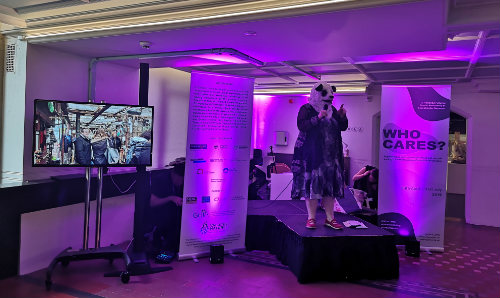Who cares?
A growing collection of stories about people caring for nature across Greater Manchester.

In January 2019 seventeen postgraduate students from the Institute of Cultural Practices admirably took on the challenge of the Professional Practice Project (PPP) module. A multi-faceted and complex project, students were tasked with making sense of the Green Infrastructure and Health and Wellbeing Influences on an Ageing Population (GHIA) research project.
Led by The University of Manchester the GHIA project is an exciting interdisciplinary research effort across universities, departments, the local authority, community partners and organisations. A five-year research project, researchers have been exploring healthy ageing in urban areas - specifically the non-monetary value of green and blue spaces across Greater Manchester. ICP students were invited to participate in GHIA and engage in its inquiry through arts management practice.
The GHIA project has brought together researchers from disciplines such as geography, arts and heritage, design, social sciences, health psychology, urban development and gerontology. Funded by the NERC, AHRC and ESRC research councils, an important aspect of the research has been for the students to work alongside and with communities and individuals who are socially engaged in caring for the green and blue spaces close to where they live.
Over the past nine months Dr Jenna Ashton and Dr Rebecca Taylor have been working closely with community groups and individuals from across Greater Manchester. Informed by this work and alongside shared interests in social action, activism, biodiversity in urban nature and socially engaged arts and design practice, Jenna and Rebecca have designed and developed a participatory action research programme. Together with participants they grew curious about, who cares about urban nature across Greater Manchester and why does it matter that we continue to do so?
The Who Cares? project then became a catalyst for participatory action research and a unique opportunity for ICP students to focus in on the stories being shared, artefacts, items and objects being collected and the insights being revealed in the process. People expressed their social action and connection to urban nature in poems, performances, campaign banners and photographs. As these stories were shared, a key challenge was identified by the participants: how do we continue our volunteer effort and motivate others to care? This opened up a unique opportunity for postgraduate ICP students to ask and act upon - how might socially engaged arts practice be applied to support those who care for and about green space and natural heritage? What might this space look like?
Through GHIA’s relationship with the Manchester Museum, ICP postgraduate students were then tasked with the concept of the first Heritage Futures Studio residency. The topics arising from GHIA appeared to connect to the four challenges identified of the Heritage Futures exhibition. Based at the museum until 2020, the exhibition invites people to engage in how society and our cultural heritage might become more aware of profusion, transformation, diversity and uncertainty.
In the Heritage Futures Studio residency, the ICP students decided to showcase an historical representation of Manchester’s parks, including the first municipal parks to be opened in the UK. This was displayed alongside a selection of objects that showcased the community activism of Friends of Nutsford Vale. Their Save Nutsford Vale (2017) campaign to stop development of the land provided insight into why they care for its existence. Alongside their story is the perspective of 'battle rapping Granny' and creative artist Joy France. Wholeheartedly committed to 'ageing playfully' Joy uses her creative practice to reflect upon the current social value of Langworthy and Clarendon Parks in Salford.
Amongst many of the lessons learned, the project has sparked intergenerational conversation about contemporary collections and how the life and vitality of stories of social action and arts practice might be displayed and archived.
On Thursday 2 May students designed and delivered a launch event at the museum and triggered an awareness of the importance of social action and community activism. The students also developed a deep appreciation for the volunteer effort of those who care for the spaces and places we run the risk of losing. The relationship students developed with performance artist Joy France was of particular importance. Joy’s creative methods revealed to the students how important it is to spend time seeing and experiencing the world and the challenges we may face through the lens of others.
Until 31 July, the Who Cares? Heritage Futures Studio residency continues to grow and evolve in the museum. It is testament to the postgraduate students of ICP that stories of social action have been provided space in a museum to be publicly visible.
The PPP module has significantly contributed to the GHIA research project. Through a transformational learning process, space has been created for people to be more deeply inquisitive of their community activism. The content of the PPP has therefore not ended, the efforts of the ICP students have not therefore been restricted to the length of a module. The life of Who Cares? continues as we also find ourselves asking; how might we co-design and curate physical and digital spaces to continue meaningful dialogue – specifically about the relationships between social action, urban nature and healthy ageing? For those who care, what might continue to be useful?
